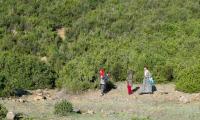As the high-level delegation from China commemorates the completion of a decade of the China-Pakistan Economic Corridor (CPEC), it is essential to reflect on the journey from vision to reality.
The start of CPEC was a concerted move by the then prime minister Mian Muhammad Nawaz Sharif and Chinese President Xi Jinping in 2013 to shift the focus of cooperation from geo-politics to geo-economics. The Belt and Road Initiative (BRI) which aims to revive the ancient Silk Road, is a centrepiece of Chinese foreign policy. As of now, more than 150 countries, with 75 per cent of the world’s population and half of the world’s GDP, have signed up to the BRI. CPEC, a principal component of BRI, aims to connect Pakistan’s Gwadar port city to China’s Xinjiang region through a network of roads, railways, and pipelines.
CPEC has the potential to significantly impact the entire region. According to the London-based Centre for Economics and Business Research, the BRI can expand the world’s GDP by $7.1 trillion per annum by 2040. Over the past ten years, CPEC has made significant progress amidst challenges and vague controversies such as debt trap, sovereignty and environmental concerns etc.
Under CPEC, both governments decided to overcome the then energy crisis in Pakistan. To guarantee energy security, multiple projects of 17,045MW, worth $33 billion, were envisaged. As of now, 13 power generation projects with a total installed capacity of 8,020MW have been achieved, including 5,000MW which is based on indigenous fuels (thar coal, hydel, solar and wind) and fall in the higher merit of dispatch order. These have substantially improved the energy-mix in Pakistan.
A first ever 660 KV HVDC transmission line with evacuation capacity of 4,000 MW is also operational. Furthermore, 884MW Suki-Kinari Hydro Power Project is expected to be ready in July 2024. Besides, 700.7MW Azad Pattan and 1,124MW Kohala Hydro Power, and a 300MW Gwadar Coal Power project, are all in the pipeline.
CPEC improved connectivity from north to south and laid a foundation for a resilient infrastructure through building motorways, port, airport, and mass transit system. In the early harvest projects, six mega projects of total 510km were completed including the Havelian-Thakot section of KKH, Multan-Sukkur (M-5) Motorway, Hakla-D.I.Khan Motorway, Eastbay Expressway and Orange Line Metro Train.
Work on various sections of the western alignment of CPEC is underway and expected to finish in July 2024. An optical fiber cable covering 820km was also laid from Khunjerab to Rawalpindi for digital connectivity. This web of high-quality expressways connecting villages with towns and cities via extended networks of feeder roads caters almost 65 per cent of our population.
CPEC is an effort to facilitate intra- and inter-country connectivity as most of these roads pass through the more remote areas of Pakistan, hoping to thus lead to better mobility, social justice, and national social cohesion. Generally, in economies like us, rural factor markets such as labour, credit, raw materials are interlocked – meaning that there is a dominant player that is the service provider in each factor market who dictates the terms of the transactions. As a result, the small helpless farmer / labourer is caught in a never-ending cycle of debt, exploitation, poverty, and low productivity – because s/he has no other options.
Connectivity is the key to end these exploitative socioeconomic relationships in rural markets. Today, almost 50 per cent of gasoline consumption in Pakistan is through motorbikes and the motorbike industry has expanded well during the last decade which is a good indication of access to mobility. This in turn has an impact on access to healthcare, economic opportunities, literacy, and poverty alleviation across the country.
The socioeconomics of Gwadar has substantially progressed due to CPEC. The Gwadar Port is operational with three multipurpose berths. The government has diverted Afghan transit trade from the Karachi Port to Gwadar and the completion of Basima-Khuzdar (N-30), which is 95 per cent complete, will further enhance the commercial viability of the port. The Gwadar Free Zone, Phase-I, which consists of 60 acres of land is complete and successfully populated. Development work on Phase-II, which consists of 2221 acres of land, is underway.
Gwadar city’s electricity problem has recently been settled by building two transmission lines: 132KV from the national grid of Pakistan, and 220KV from Iran for provisioning of additional 225MW electricity. Water availability has been ensured, and Gwadar city is now connected with the Sawd and Shaidkur dams through 7 MGD pipelines and a 1.2 MGD desalination plant is also about to start its operations in a few weeks.
The Eastbay Expressway and the Pak-China Technical & Vocational Institute are fully operational. More than 500 students from Gwadar City are being trained in various fields. The marketing and investment plan for the port and the free zone is ready for implementation. Further to Gwadar’s Master Plan, the government is developing a micro land-use plan and governance framework of the city. The Balochistan Assembly has enacted a law granting special status to Gwadar City wherein 12,00 sq km area of the city has been exempted from all provincial taxes including sales tax on services, and provincial cess.
Furthermore, 3,150 solar units have been installed on the rooftops of the poorest households. This generous gesture by China has brought good will among the local community. The construction of the New Gwadar International Airport and the Pak-China Friendship Hospital is about to be completed in a few months. These developments indicate that Gwadar’s livelihood is expected to improve manifolds.
In industrial cooperation, only four Special Economic Zones (SEZs) out of nine are advancing. Rashakai, with 270 acres, was inaugurated in July 2023 with 23 industrial plots already allotted. Development work at the Allama Iqbal Industrial City is progressing; 126 plots of the AIIC have been allotted so far. The groundbreaking of Dhabeji was held in July 2023 and civil works are underway. Bostan SEZ, Phase 1 with 200 acres is being developed; 19 industrial plots have been allotted.
Many Chinese businesses are relocating to low-cost destinations but we could not attract them here. This is so because most of these SEZs were to be operational by June 2020 but Covid-19 and grave slackness on the part of the previous regime delayed the fruits of this initiative.
In science & technology, capacity building of teachers regarding STEM education, mutual recognition and accreditation of engineering education, Joint Research Centre on Earth Sciences, Technology Transfer Centre, Institute of Smart Semiconductor Technology and Huawei Technical Support Centres are the key initiatives.
Under agricultural cooperation, the present government has signed various agreements and protocols to exchange high-quality germplasm resources and encourage G2G and B2B cooperation where research organizations and enterprises have joined hands in the fields of animal husbandry, crop cultivation and product processing to enhance export and employment opportunities.
China pledged a grant of $1 billion for socio-economic development under CPEC, besides extending several scholarships; right now, over 25,000 Pakistani students are studying in China in various disciplines. Overall, approximately over 200,000 direct jobs have been created for locals including engineers in the CPEC projects during these 10 years.
Working with full hope and acting in unison with great motivation can pave the way for making the dream of shared prosperity come true. We need to also acknowledge our Chinese friends who successfully executed these projects. Our security officials deserve appreciation for leaving no stone unturned to keep them safe and comfortable.
The dedication of the focal persons of the line ministries, untiring efforts of the CPEC Secretariat staff and the leadership of Planning Minister Planning Prof Ahsan Iqbal – who is also known as Mr CPEC – deserve the highest praise for having brought CPEC to its fruition.
The writer is the chief economist of Pakistan, and also heads the CPEC Secretariat at the Ministry of Planning, Development and
Special Initiatives.
There are over 11 million Pakistanis settled abroad, out of which around six million work in Gulf and Middle East
This year alone, US Treasury would have to roll-over $10 to $14 trillion in maturing short-term debt
Tear gas no longer marks just protest sites; it paints entire cities as battlegrounds but then again, PTI did it first
Political structures and governance systems have been central to economic and social development
It is confirmed now 40 Pakistanis had died after boat of migrants had capsized in sea near Greece
Many people believe that in future, AI will play an even more significant role in their lives







